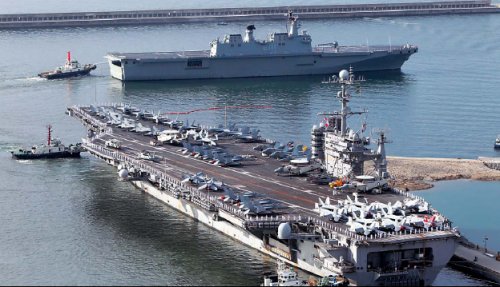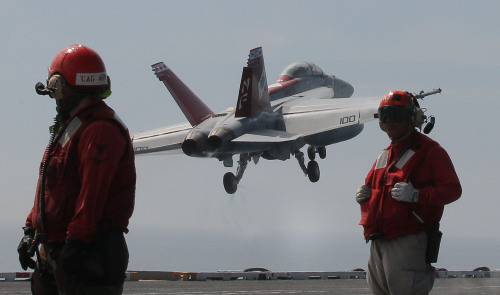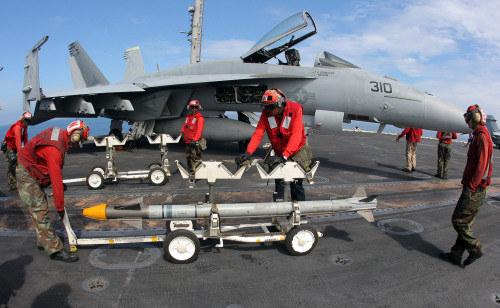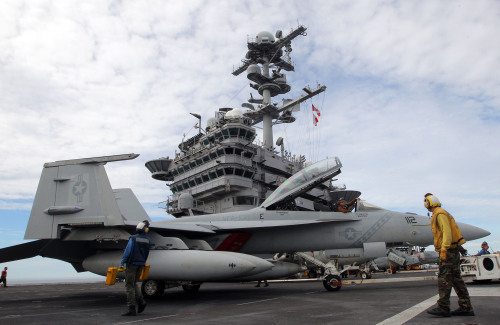North Korea warns of 'revengeful holy war'
South Korea and the United States kicked off a four-day joint military exercise in the East Sea on Sunday in a display of force against North Korea accused of launching a torpedo attack on the corvette Cheonan in March.
The two allies have mobilized some of their key military assets, including the 97,000-ton aircraft carrier USS George Washington and four F-22 stealth fighter jets, for the maritime and air exercise, codenamed “Invincible Spirit.”
Apparently unnerved by the drill intended to send a clear warning message to the communist state, North Korea threatened Saturday to begin a “revengeful holy war.”
South Korea and the United States kicked off a four-day joint military exercise in the East Sea on Sunday in a display of force against North Korea accused of launching a torpedo attack on the corvette Cheonan in March.
The two allies have mobilized some of their key military assets, including the 97,000-ton aircraft carrier USS George Washington and four F-22 stealth fighter jets, for the maritime and air exercise, codenamed “Invincible Spirit.”
Apparently unnerved by the drill intended to send a clear warning message to the communist state, North Korea threatened Saturday to begin a “revengeful holy war.”

“We will confidently respond to (the joint exercise) with our powerful nuclear deterrence capabilities,” said a spokesperson for the North’s National Defense Commission, a top military decision-making body, via the state-run Korean Central News Agency.
“In response to the U.S. and the South Korean puppets deliberately driving the situation to the border of war, we will open a revengeful holy war based on our nuclear deterrence force at a necessary time.”
The North has denied its culpability for the incident that took the lives of 46 sailors. The two Koreas still remain technically at war as the 1950-53 Korean War ended in a truce, not a peace treaty.




The exercise is one of a number of drills scheduled in the coming months in the East and West seas. In September, the two allies plan to conduct an intensive maritime drill in the West Sea.
The exercise was initially expected to be conducted in the West Sea with the deployment of the aircraft carrier. However, apparently considering strong objections from China, Seoul and Washington decided to conduct the exercise in the East Sea.
Some analysts here had said the exercise might be part of the “exit strategy” to move forward after the Cheonan incident. However, the United States last week presented a set of new sanctions, which it said would target the North Korean leadership, reaffirming its resolve to have the North take responsibility for the incident.
The North has begun talking about peninsular peace and expressed willingness to return to the stalled denuclearization talks in an apparent move to divert international attention from the sinking, which the Seoul-led multinational investigation team held the North culpable for.
In addition to the aircraft carrier, the South Korean and U.S. militaries have mobilized some 20 naval vessels, including the 14,000-ton amphibious landing ship Dokdo, 3,200-ton KDX-I and 4,500-ton KDX-II destroyers, a 1,800-ton submarine and a research vessel.
The nuclear-powered carrier belonging to the U.S. Seventh Fleet based in Yokosuka, Japan, has an operational range of 1,000 kilometers. The sixth Nimitz-class vessel, commissioned in 1992, carries some 5,000 crew and more than 40 aircraft.
Some 200 military planes participating in the exercise include fighter aircraft such as the F/A-18E/F Super Hornet and the F/A-18A/C Hornet. They also include the E-2C Hawkeye airborne early warning aircraft, the P3-C antisubmarine surveillance aircraft, Lynx antisubmarine helicopters, and F-15K and KF-16 fighter jets.
It is the first time for the F-22 Raptor to be deployed on training missions in and around the Korean Peninsula. With its combination of stealth, speed, agility, precision and situational awareness, combined with air-to-air and air-to-ground combat capabilities, it is regarded as one of the most advanced combat aircraft.
For the exercise, some 8,000 service members from the two allies’ armies, navies, air forces and marines are taking part.
Four officers from Japan’s Maritime Self-Defense Force have also joined the drill as observers aboard the U.S. aircraft carrier. It is the first time for Japanese military officers to join a joint drill in South Korea.
Operatives from the U.S. cyber command have also joined the exercise, which includes drills on network defense warfare, fuel supplies, antisubmarine operations and aerial refueling.
By Song Sang-ho (sshluck@heraldcorp.com)










![[Today’s K-pop] BTS pop-up event to come to Seoul](http://res.heraldm.com/phpwas/restmb_idxmake.php?idx=644&simg=/content/image/2024/04/17/20240417050734_0.jpg&u=)
![[Graphic News] More Koreans say they plan long-distance trips this year](http://res.heraldm.com/phpwas/restmb_idxmake.php?idx=644&simg=/content/image/2024/04/17/20240417050828_0.gif&u=)
![[KH Explains] Hyundai's full hybrid edge to pay off amid slow transition to pure EVs](http://res.heraldm.com/phpwas/restmb_idxmake.php?idx=644&simg=/content/image/2024/04/18/20240418050645_0.jpg&u=20240419100350)




![[KH Explains] Hyundai's full hybrid edge to pay off amid slow transition to pure EVs](http://res.heraldm.com/phpwas/restmb_idxmake.php?idx=652&simg=/content/image/2024/04/18/20240418050645_0.jpg&u=20240419100350)

